|
cover & contents page | Rise & Fall of Kerry & Co | The Man & The Photographer | The Collection | The Plates | Biography | Kerry page
The Plates
These plates are those used in David Millar's book. There listed under group titles. The scanned copies have been upoaded here on two pages.
Set One (Below):
Sydney Plates 1–23 / Landscapes Plates 24–29 / Aboriginals Plates 30–31 /The Selector Plates 32–39
Set Two (Click here):
Rural Industry Plates 40–46 / Recreation Plates 47–50 / Wheat Farming Plates 51–53 / Sheep Farming Plates 54–65 / Cattle Farming Plates 66–72
____Sydney
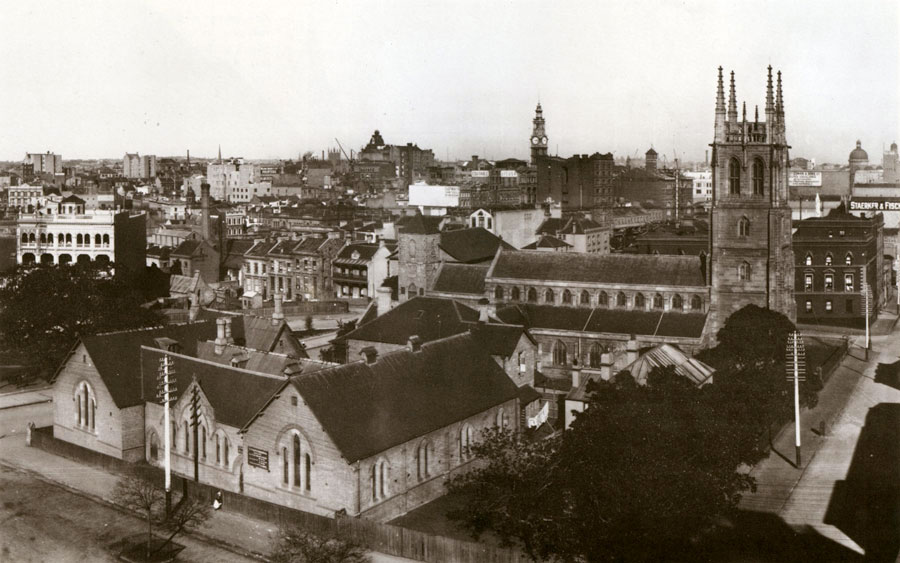 |
Plate 1: Churuch Hill. Sydney
Designed by Edmund Blacket in the 1850s, St Philip's Anglican Church replaced the first church erected in 1798. The vicarage and school have been swept away, as has the austere Scots Church, where the irrepressible and caustic Dr J. D. Lang was minister. The photograph was taken about 1910. |
| |
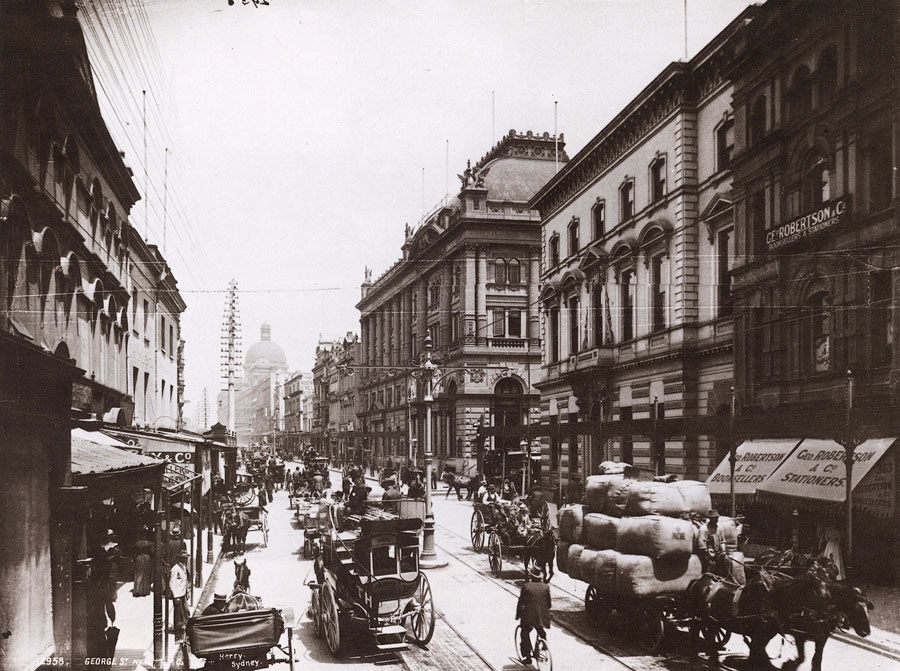 |
Plate 2: George Street near GPO
This photograph, taken by William van der Velden, one of Kerry's field operators, was shot from a mobile scaffold, surmounted by a self-levelling platform and camera which was trundled around Sydney until a likely view was selected. Sydney's leading retail bookshop, George Robertson's, can be seen on the right. |
| |
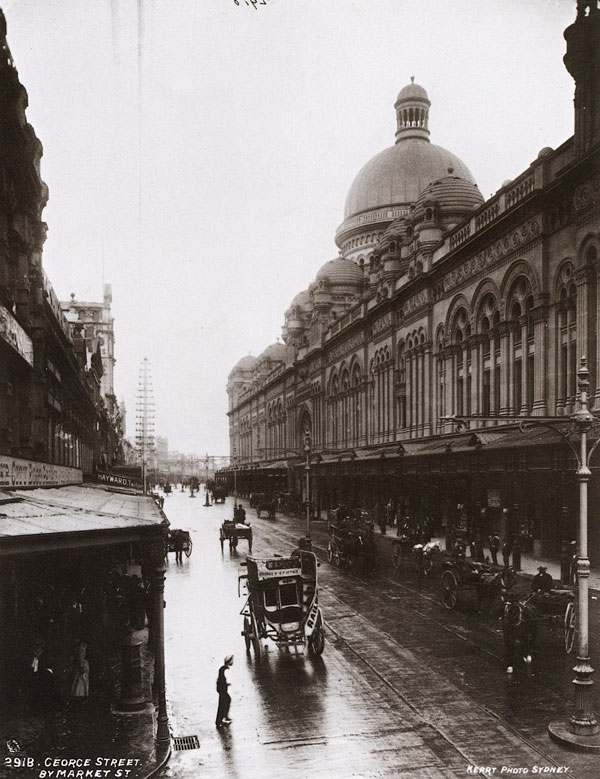 |
Plate 3: George Street by Market Street
The Queen Victoria Building was erected in a record time of four years during the depression of the 1890s to replace old markets on the site. George McRae, City Architect, designed a massive Romanesque palace, with markets in the basement and shops on the two-level arcade. As the cast iron awnings are in place, we know that this photograph was taken no earlier than 1905 and no later than 1917 when a cantilevered awning was erected in their place. A gem of High Victorian building, its style, although new to Sydney, was then very fashionable in the USA.
|
| |
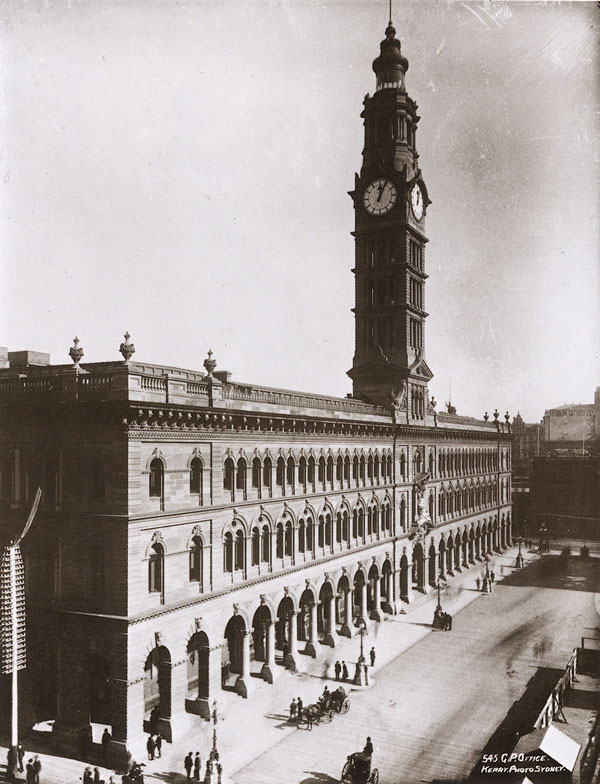 |
Plate 4: The GPO Building
James Barnet, Government Architect, designed this building which was completed in 1887 after twenty-three years of fitful construction. The Italianate quality of the building has never been fully appreciated. The fountains intended for the front of the building were never constructed and the State Government sold the northern portion of the projected piazza to private enterprise. Their buildings turned a sunny square into a dark void. The rapid growth of telecommunications in later decades forced the clean lines of the 'palazzo' to become cluttered by the addition of attic storeys and mansard roofs for house telephone services and administration. Note the builder's hoardings, in preparation for the erection of the buildings on the northern portion of the open square between 1898 and 1901.
|
| |
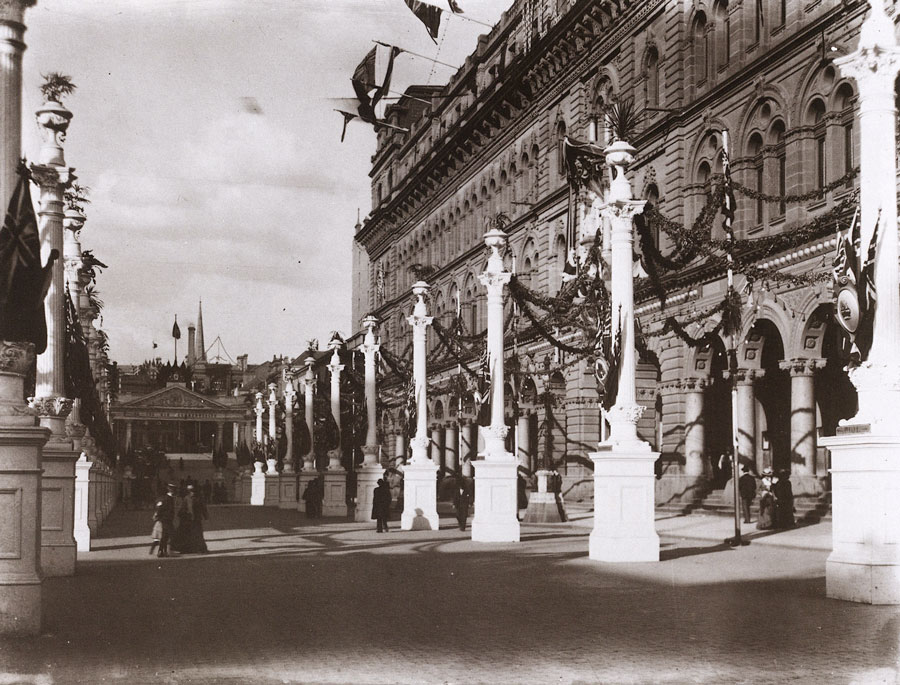 |
Plate 5: Martin Place, 1901
Decorated for the NSW Commonwealth celebrations of 1901. As can be seen, Martin Place did not yet extend from Phillip Street to Macquarie Street, and the spire of the now demolished St Stephen's Presbyterian Church can still be seen on the skyline, rising from its site in Phillip Street. |
| |
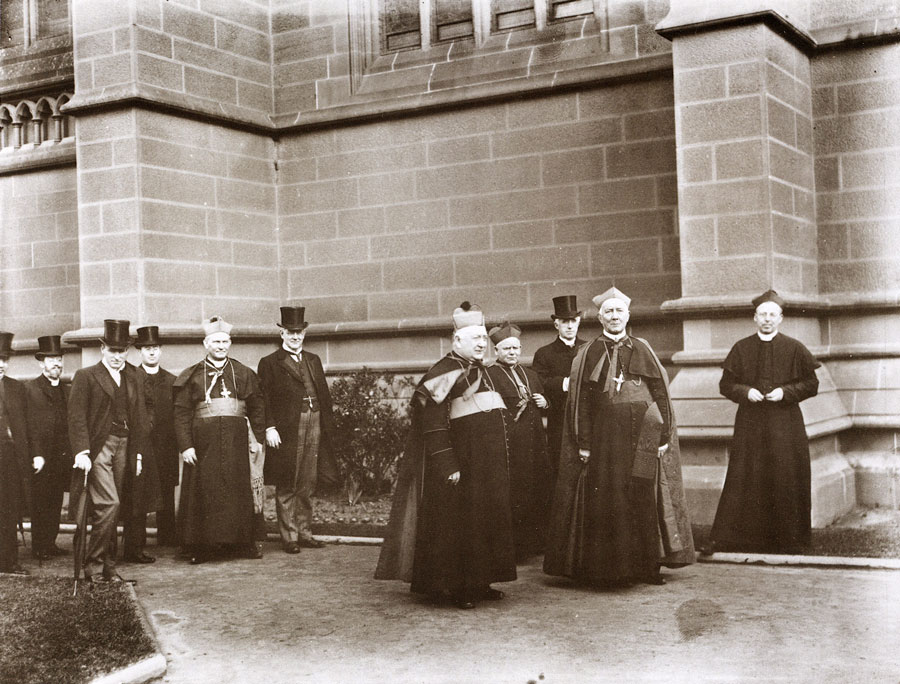 |
Plate 6: Group at St Mary's Cathedral, Sydney
This photograph shows a group at the side of St Mary's Roman Catholic Cathedral. The occasion was a meeting prior to the Australasian Catholic Congress of September-October 1909. Pictured from the left to right arc Father Reginald Bridge (with beard), Mr T.J. Dalton (in top hat), unknown cleric, Bishop Patrick O'Connor of Armidale, Hon. John Hughes, MLC (top hat), Archbishop Thomas Carr of Melbourne, Bishop J. Gallagher of Goulburn, Monsignor O'Brien, Rector of St John's, University of Sydney (top hat), Cardinal Moran and Monsignor Denis O'Haran. |
| |
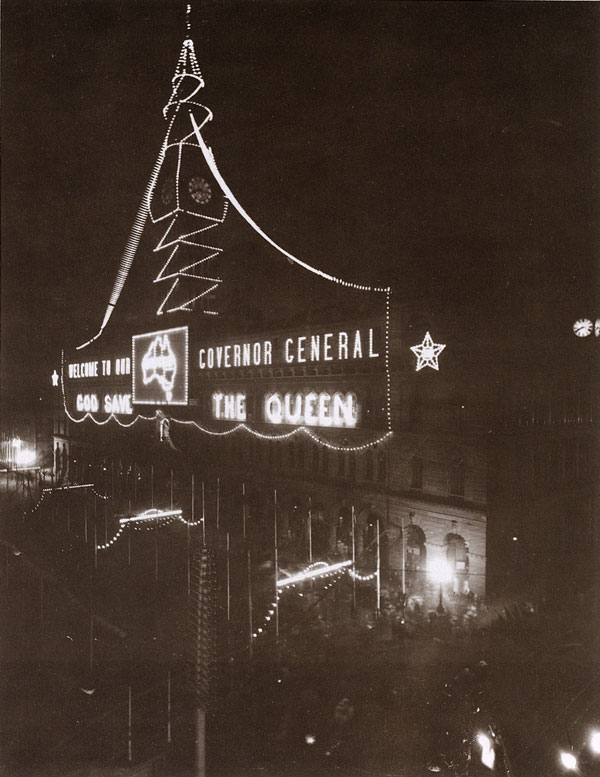 |
Plate 7: GPO at night
Covered with electric lights, the first time such a spectacular technique had been used in Sydney, the GPO spells out the city's welcome to John Lewis Hope, Earl of Hopetoun, Australia's first Governor-General. Hope, who arrived in Sydney on 15 December 1900, had once been a very popular Governor of Victoria.
|
| |
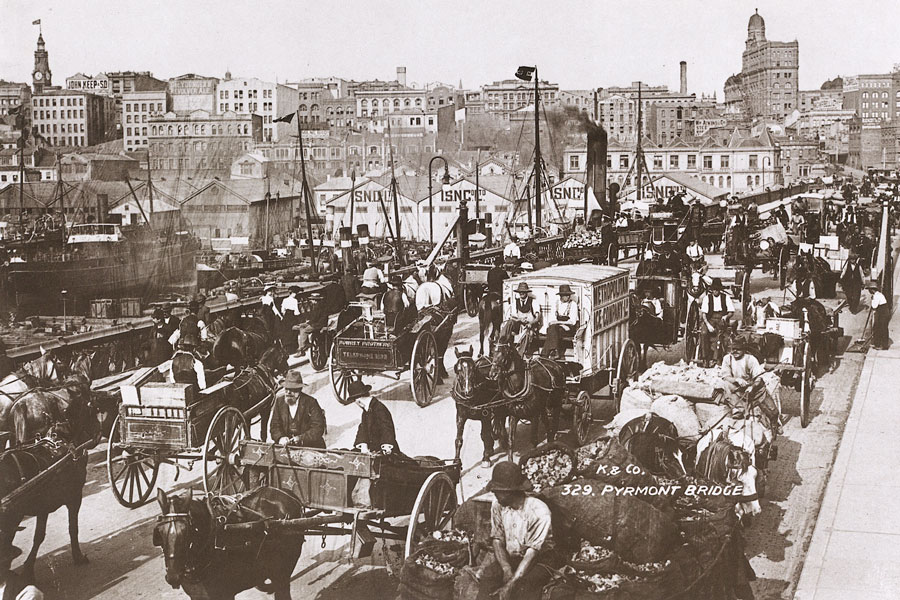 |
Plate 8: Pyrmont Bridge
A scene on the recently opened 1902 bridge taken from the operating tower from which the central span could be swung aside to let vessels through. |
| |
 |
Plate 9: Sydney Cove
This view across the Cove, from B. Macbeth's boatbuilding yard, shows Fort Macquarie, on Bennelong Point, and two men-of-war in Farm Cove. |
| |
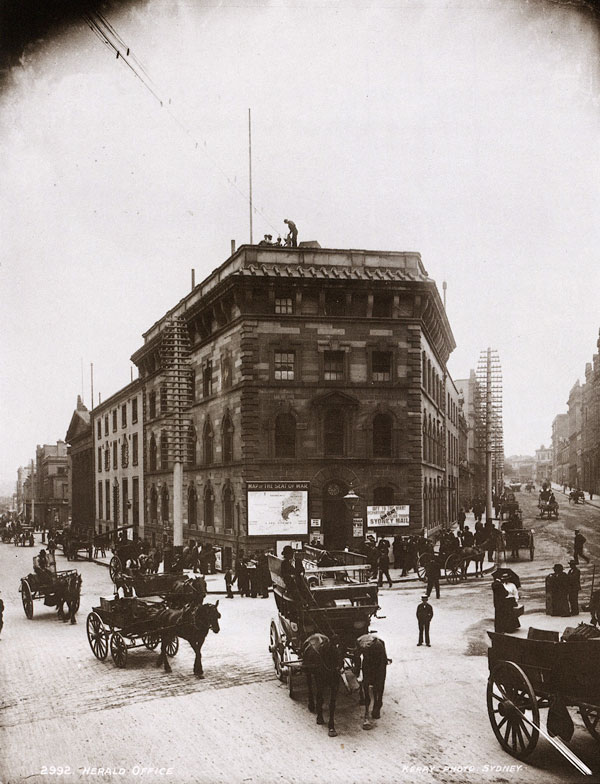 |
Plate 10: Herald Office
Kerry took this photograph in January 1901 after Australian troopers had left for South Africa. Looking at it through a magnifying glass, one can see the public jostling to look at photographs of the embarkation at Circular Quay, posters proclaiming the latest news from Lady-smith, and a large map showing, by coloured markers, the slow advance of the Imperial troops into the Transvaal. The Herald's office was at 38 Hunter Street.
|
| |
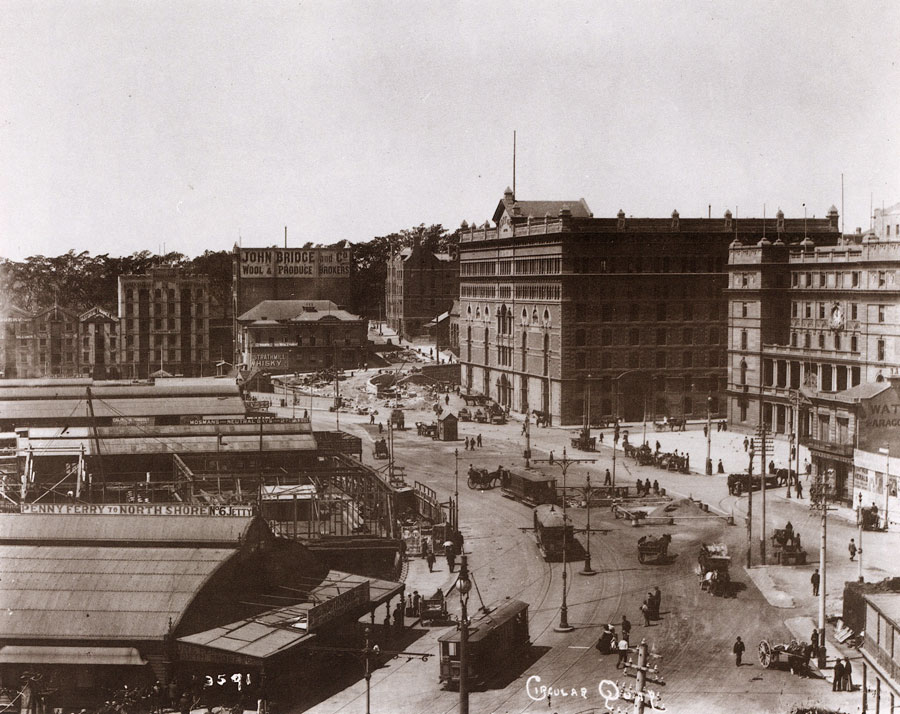 |
Plate 11: Circular Quay
Dominating Circular Quay is Mort and Co.'s wool stores, strategically placed for the loading of wool into ships berthed alongside the Quay. This marvellous fortress-like building was demolished in 1960 to make way for the AMP's 26-storey head office, the first building to take advantage of new Council height regulations. |
| |
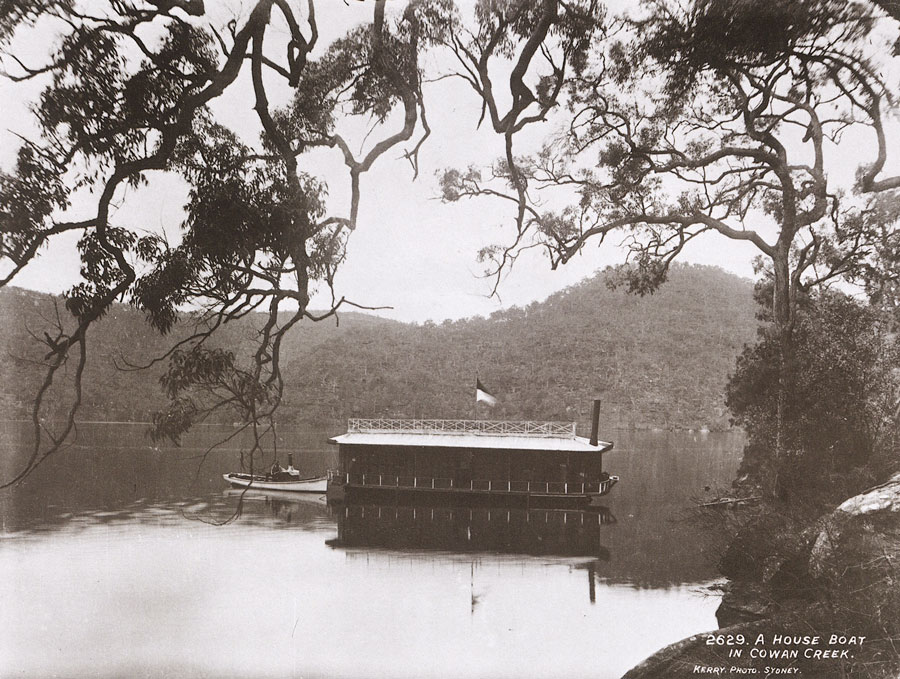 |
Plate 12: A House Boat in Cowan Creek
This photograph is one of the few by Kerry for which contemporary comment has been discovered. The Australasian Photographic Review, October 1898, reported that this picture 'is one ot the recent additions of this firm to their exciting collection of characteristic Australian views, and is one of the choice "bits" that await the operator in Kuringai Chase'. |
| |
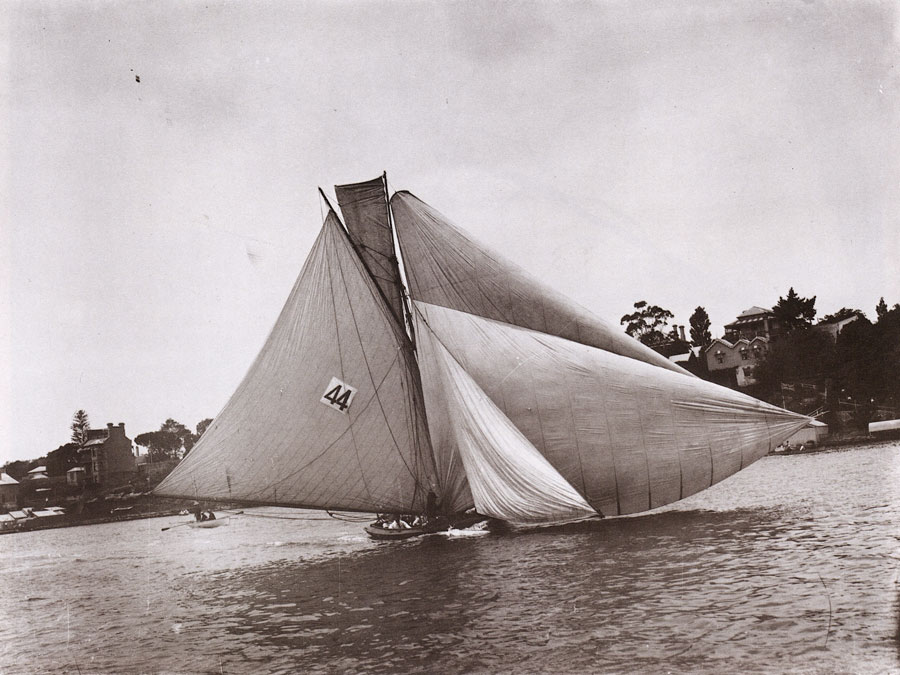 |
Plate 13: Yachting in Sydney Harbour
This 22-foot (6.7 m) skiff has rounded Long Nose Point, Birchgrove. The crew has gybed the spinnaker on rounding the point. The photograph dates from about 1892. |
| |
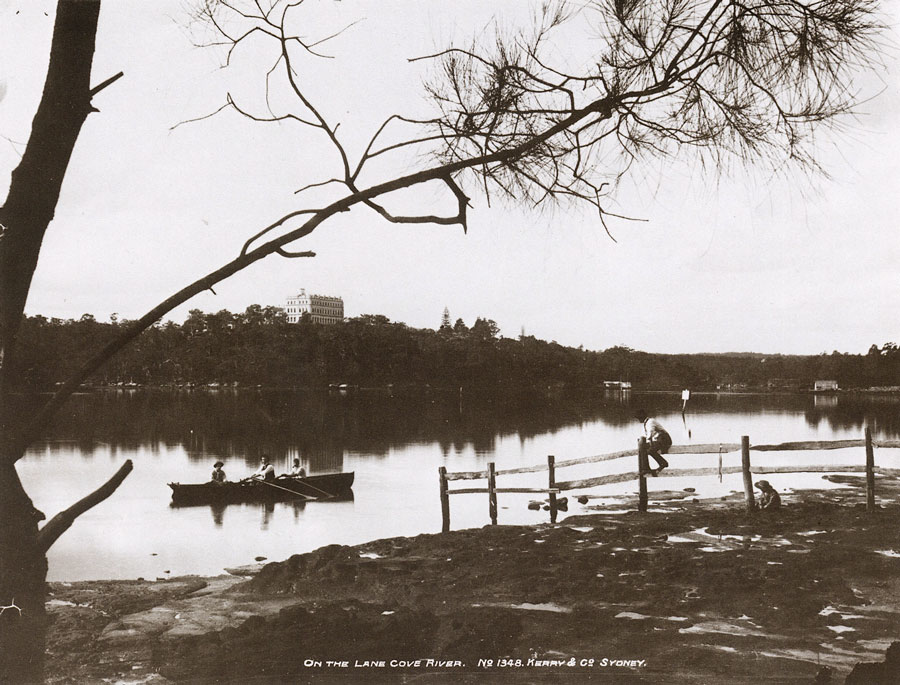 |
Plate 14: On Lane Cove River
Here is a tranquil scene, with Father Joseph Dalton's school reflected in the water. Established in Hunters Hill in 1880, St Ignatius' College, shown dominating the skyline, began as a small stone cottage. |
| |
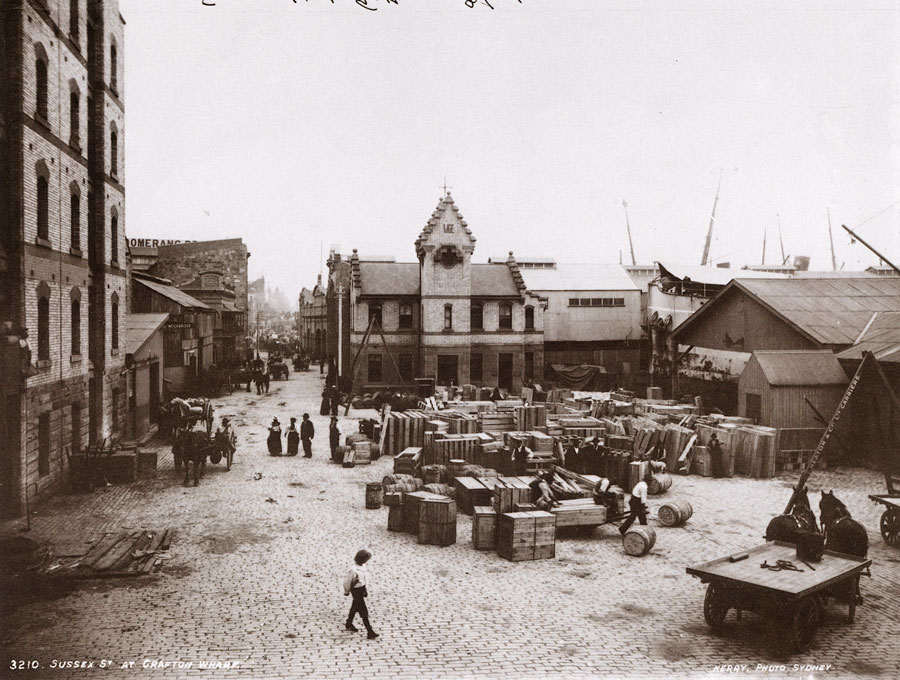 |
Plate 15: Sussex Street at Grafton Wharf
Nestling over Grafton Wharf is a delightful office block, No.1 Sussex Street, designed by William Wardell, the architect of St Patrick's Cathedral, Melbourne |
| |
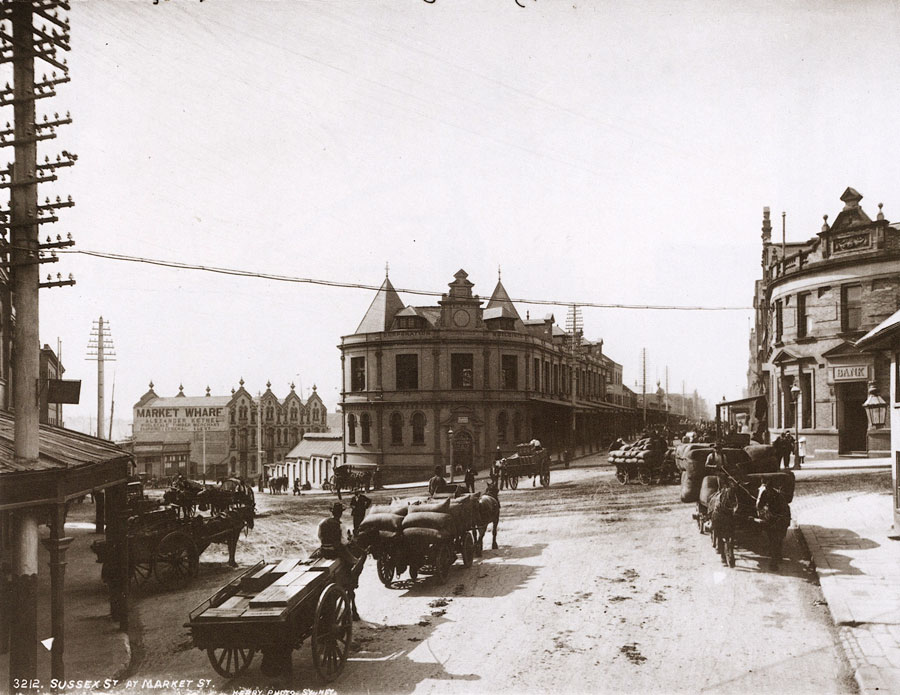 |
Plate 16: Sussex Street at Market Street
This .photograph is dominated by the Corn Exchange building, built in 1887. As well as a corn exchange it was also a pig and fruit market on the lower level. |
| |
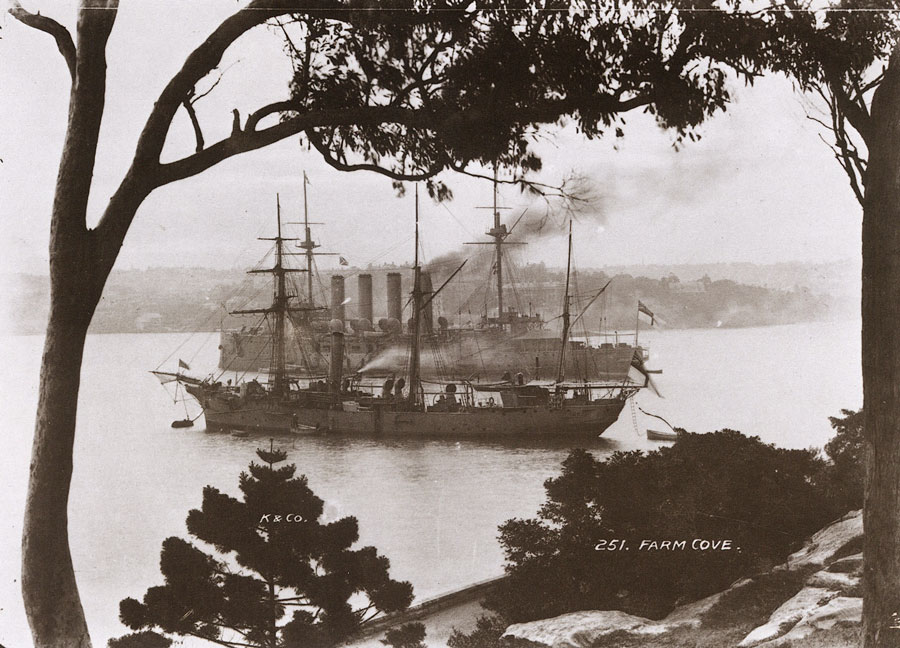 |
Plate 17: Farm Cove
Two ships of the Australian Station at anchor in Farm Cove. The four-funnelled warship is the cruiser HMS Powerful, one of the larger vessels then afloat. Built as a long range escort for trade routes, she had a range of 11,000 kilometres at 14 knots. She was flagship of the Australian Station, 1905-1912. The smaller vessel, HMS Penguin, was a composite sloop of the Wild Swan class. She came to Sydney in 1890 as a survey vessel, being paid off in 1907. |
| |
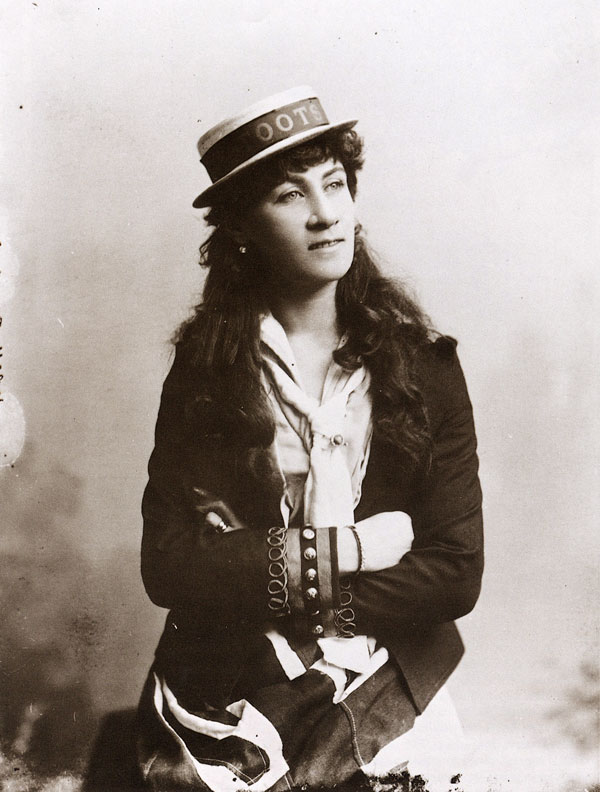 |
Plate 18: 'Toots" ~ Mrs H Richards
|
| |
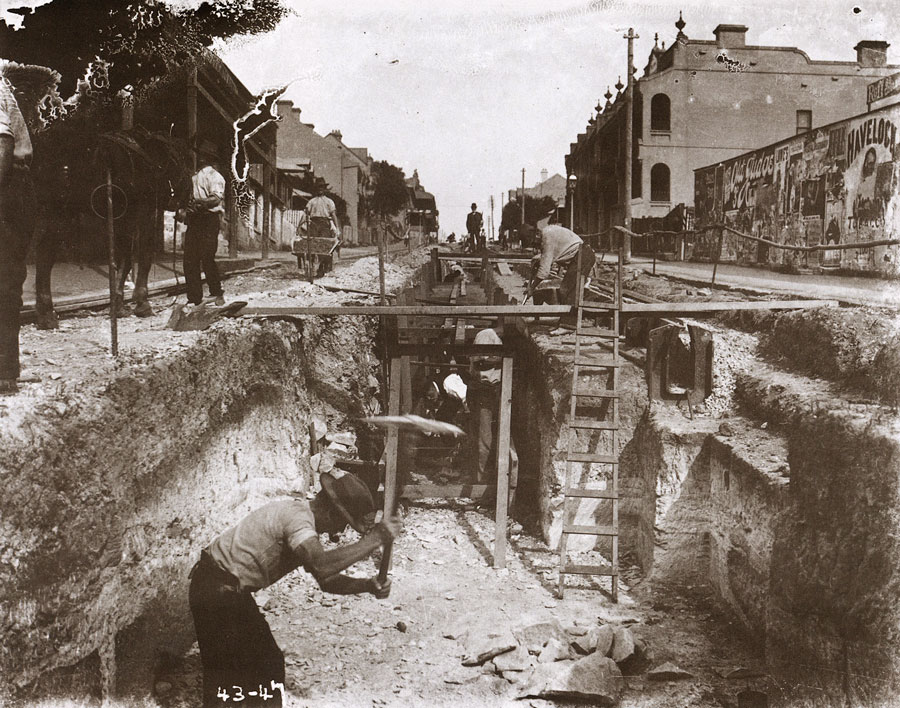 |
Plate 19: Darling Street, Balmain
Workmen excavate the cable channel above which a dummy would run. This dummy acted as a counterweight for trams moving down the steep slope to Darling Street Wharf. Photographs of labourers working are rare in an age when scenic views and portraits were considered the only proper subjects for the photographer. |
| |
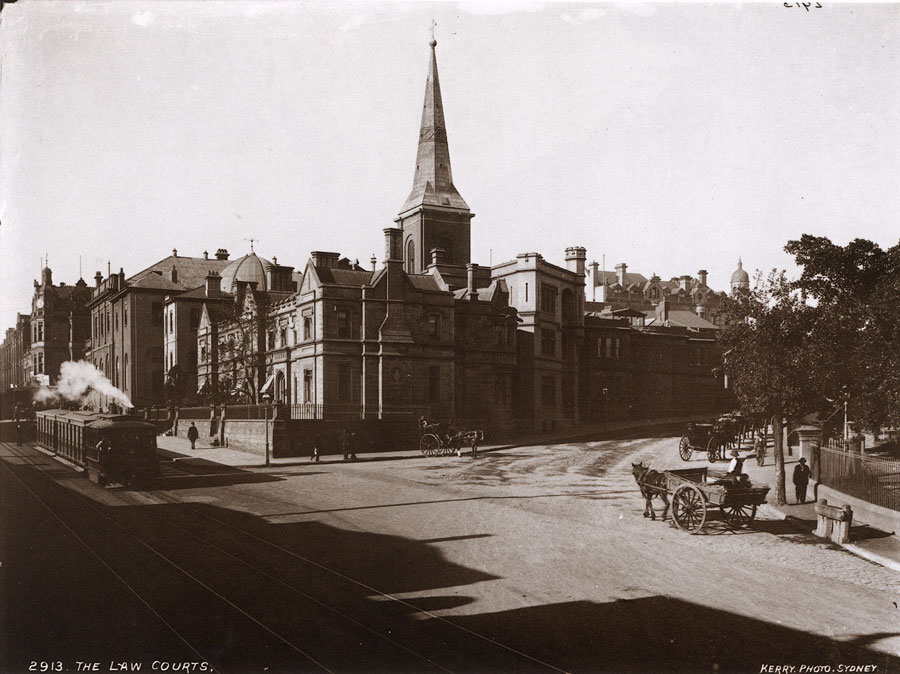 |
Plate 20: The Law Courts
Passing the old Supreme Court building and the Tudor Revival Registrar-General's Office, is steam tram no. 97 and its 70-passenger trailing car. The Baldwin Locomotive Works in Philadelphia manufactured these steam trams, which ran on the City-Paddington-Bondi Junction route from July 1891 until 1901, when the city section of the line was electrified. |
| |
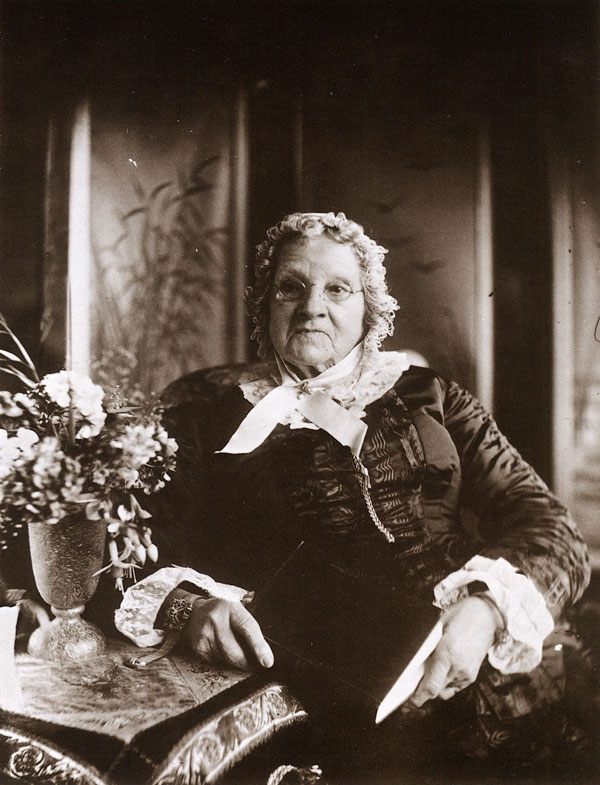 |
Plate 21: Mrs Ramsay
|
| |
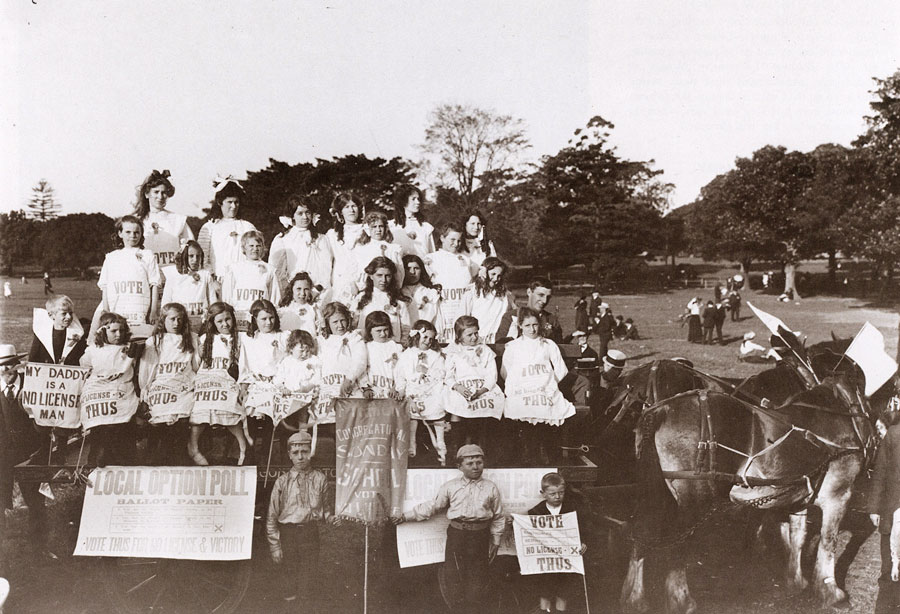 |
Plate 22: A Prohibition Parade
This shows the Pyrmont Congregational Sunday School on their wagon In the Sydney Domain |
| |
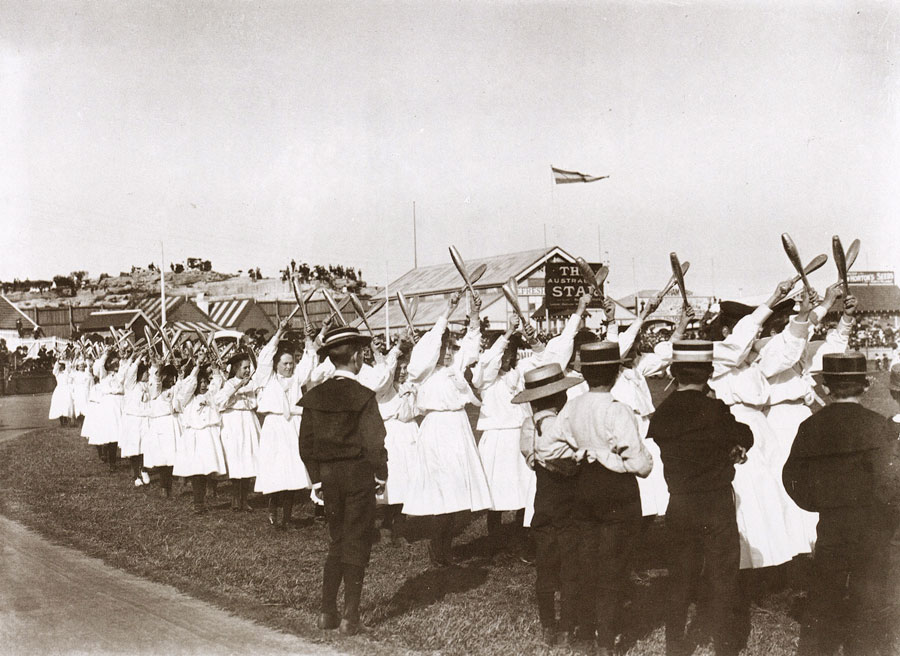 |
Plate 23: New South Wales Schools Annual Demonstration |
____Landscape
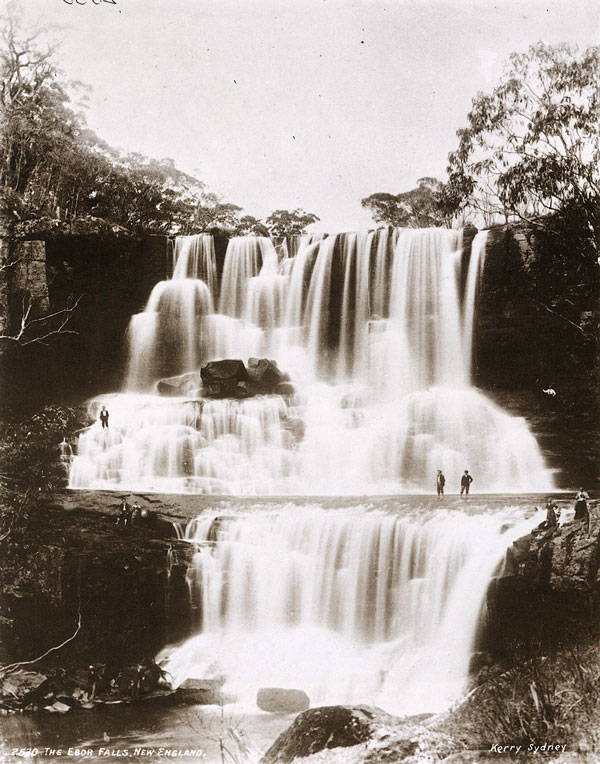 |
Plate 24: The Ebor Falls, New England, NSW
|
| |
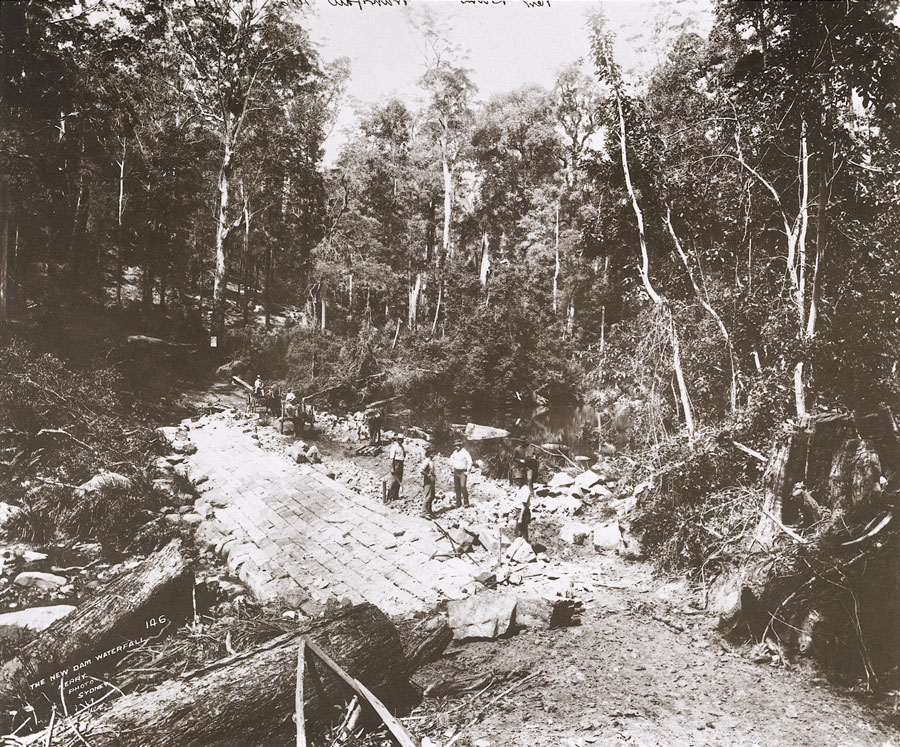 |
Plate 25: The New Dam, Waterfall
Workmen in 1895 at the southern extremity of the Royal National Park are seen here laying a dam and ford. The notice on the tree in the middle distance advises the public that the taking of trees, ferns or plants from the Park is forbidden. |
| |
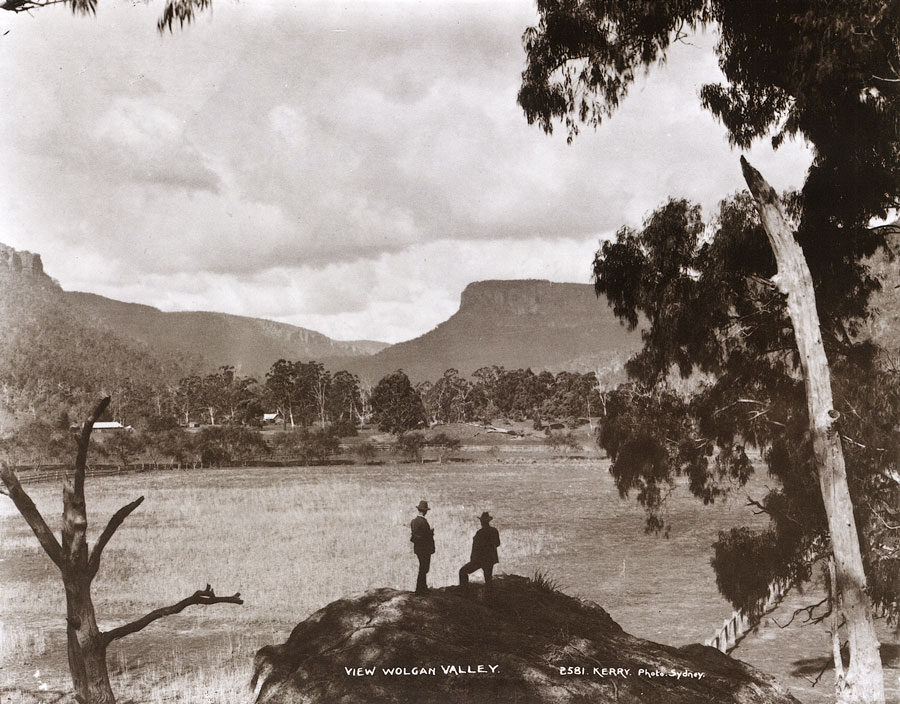 |
Plate 26: View Wolgan Valley |
| |
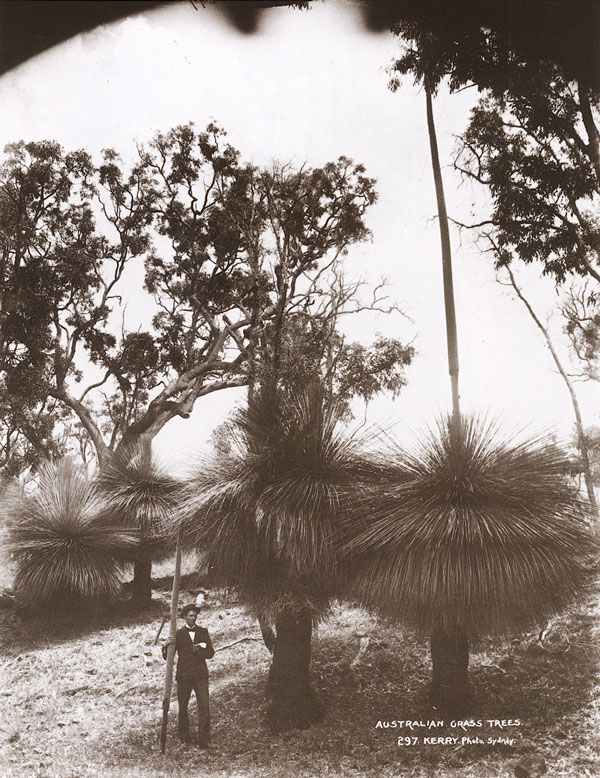 |
Plate 27: Australian Grass Trees
|
| |
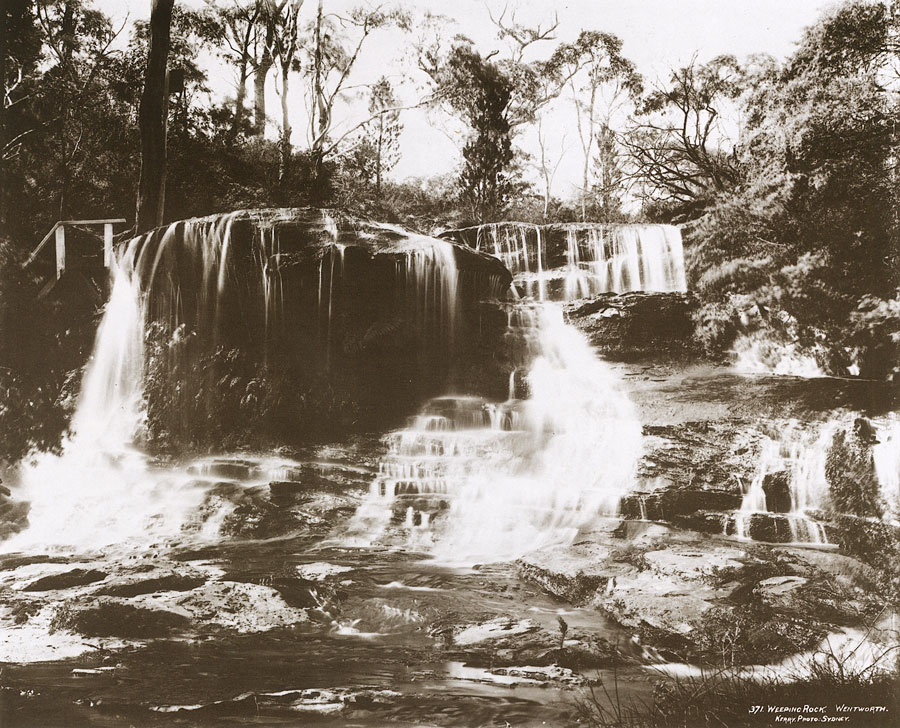 |
Plate 28: Weeping Rock, Wentworth, NSW |
| |
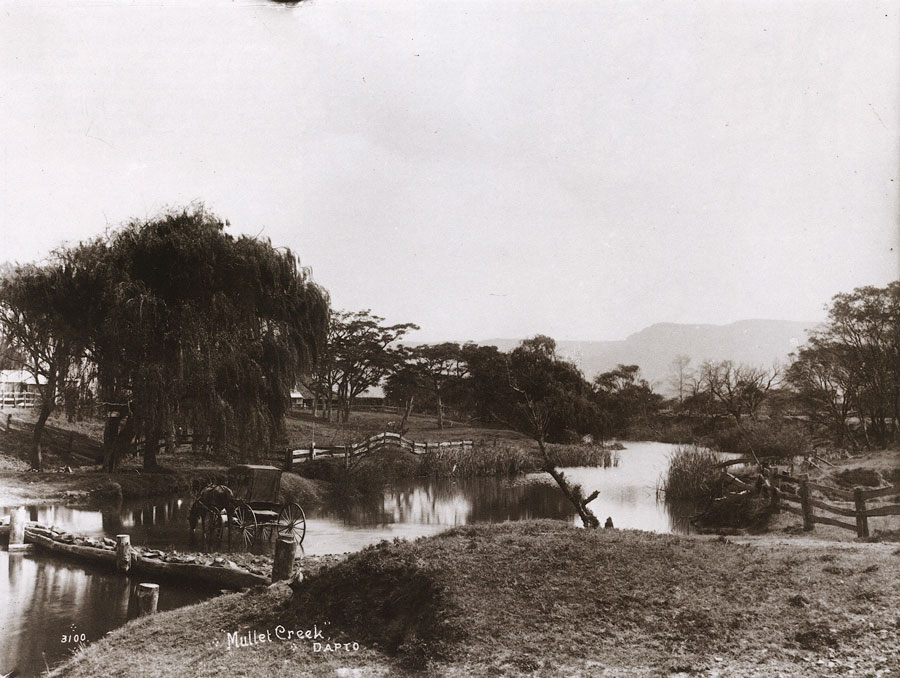 |
Plate 29: Mullet Creek, Dapto |
____Aboriginals
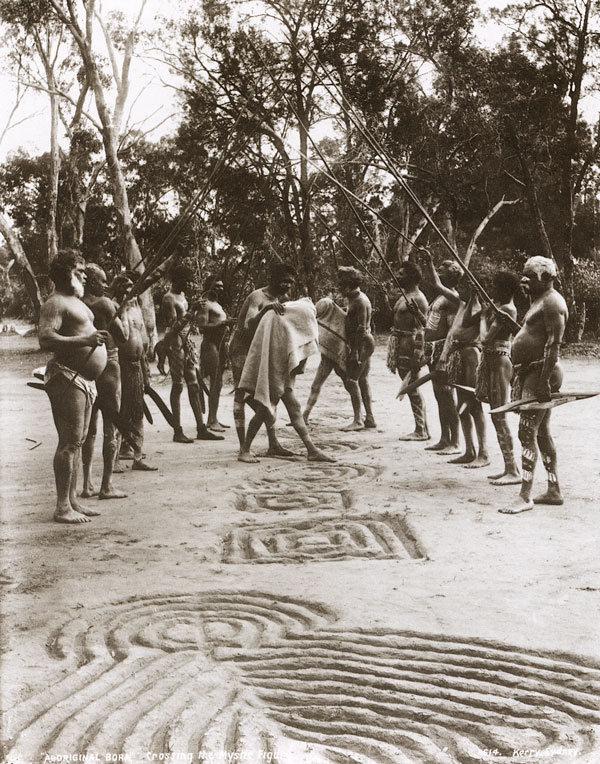 |
Plate 30: Aboriginal Bora, Crossing The Mystic Figures
Sometime ago our Mr Kerry had the good fortune (which has been shared by only two or three other living travellers) to view a Genuine Bora Ceremony, which is the sole religious rite of the Aboriginal. But not only did Mr Kerry view it, he also photographed it.' From a 1908 catalogue, Kerry's Collotype Postcards. |
| |
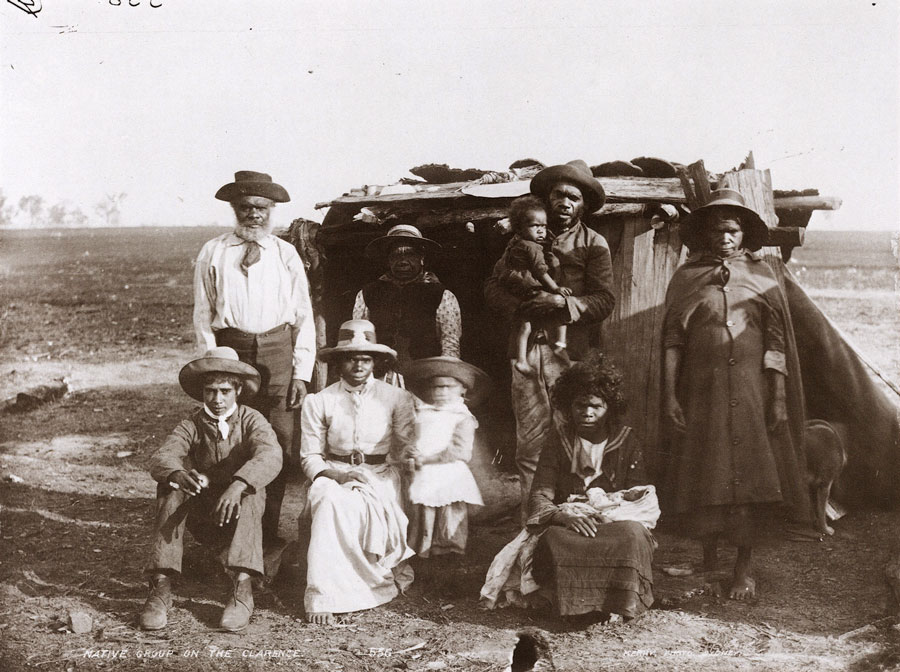 |
Plate 31: Native group on the Clarence River |
____The Selector
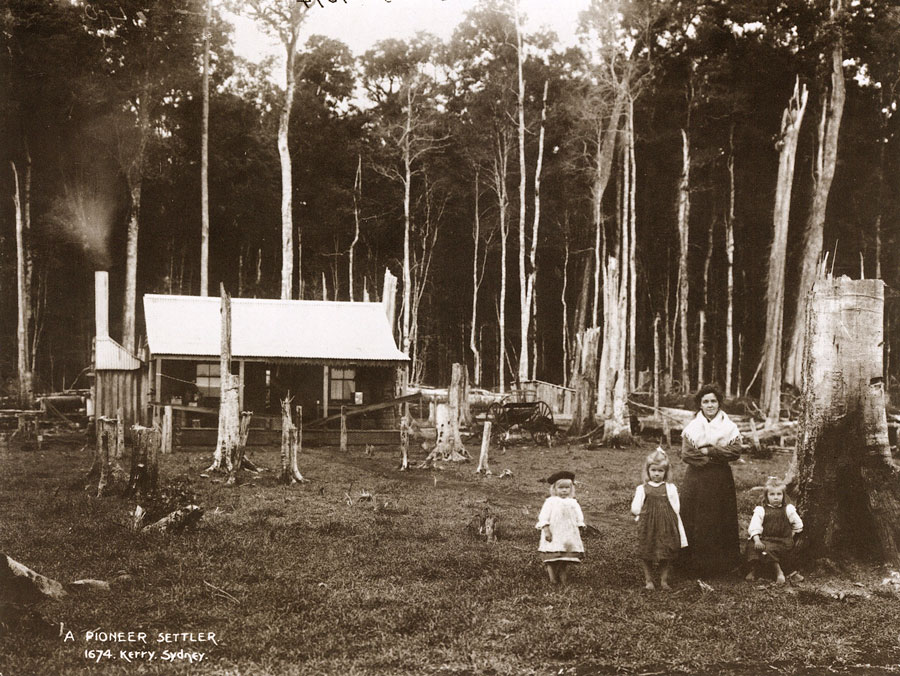 |
Plate 32: A Pioneer Settler
Taken at Dorrigo, New South Wales, the photograph shows the lot of many selectors. Settling on between 16 and 128 hectares of Crown Land, and paying it off over a long period, these farmers were known as 'cockies'. Some lived comfortably, but most experienced a hard life, as Steele Rudd reminds us in his On our Selection. |
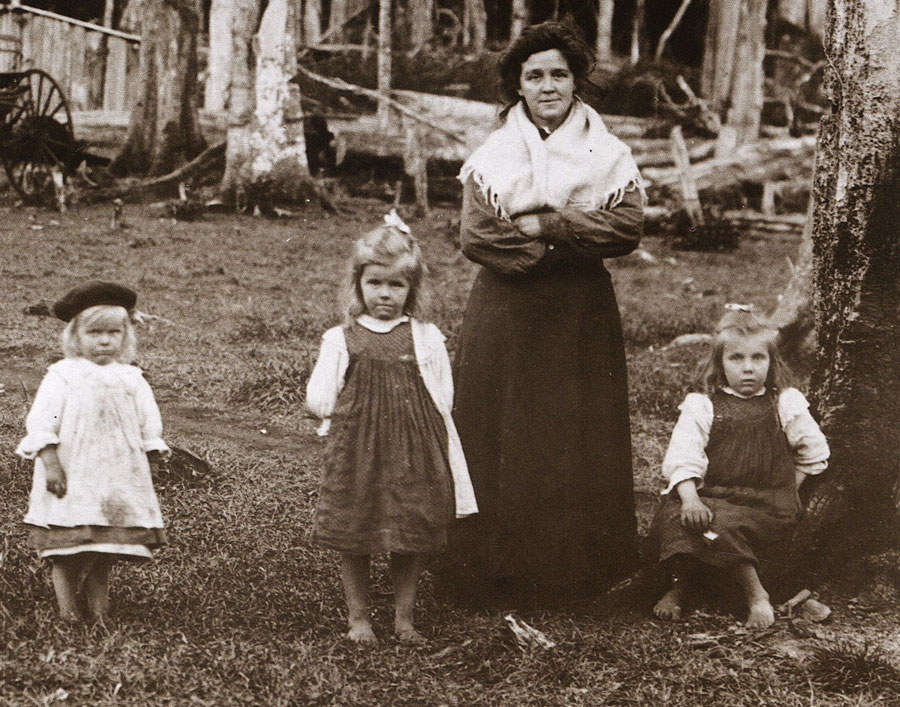 |
| |
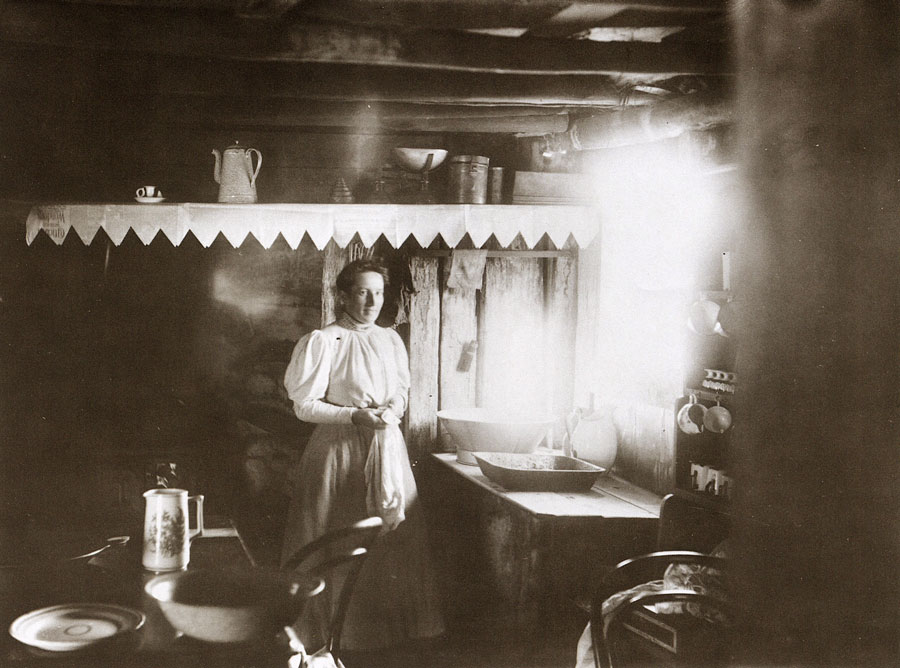 |
Plate 33: Inside a Selector's House
This is a rare interior photograph. From 1861 in New South Wales, selectors could buy land from the Government to set up small farms. These 'cockies' formed a rural proletariat and created a division in the country that gave the Labor Party a considerable power base for many years. |
| |
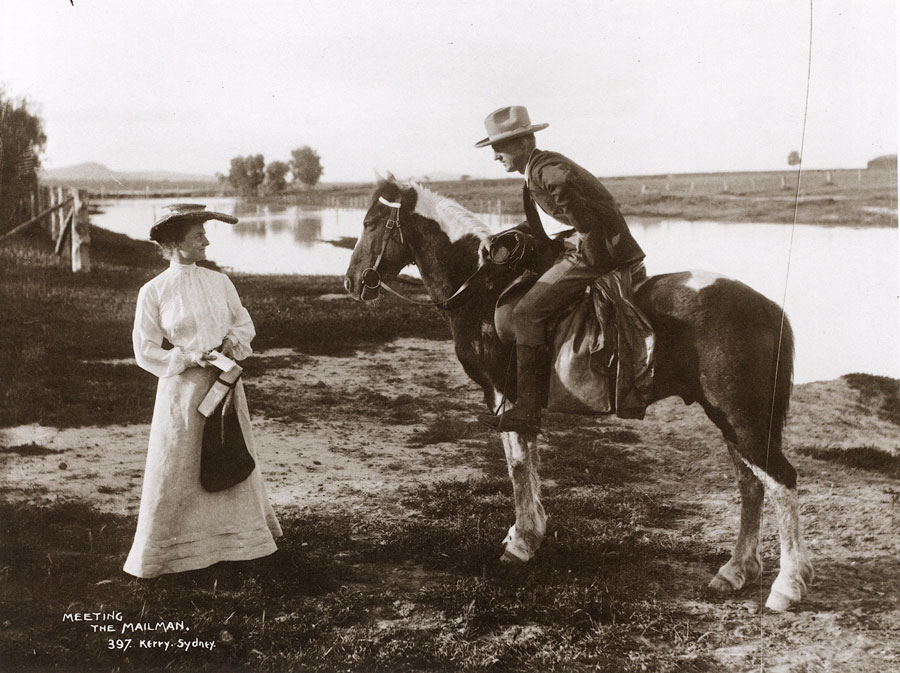 |
| Plate 34: Meeting the Mailman |
| |
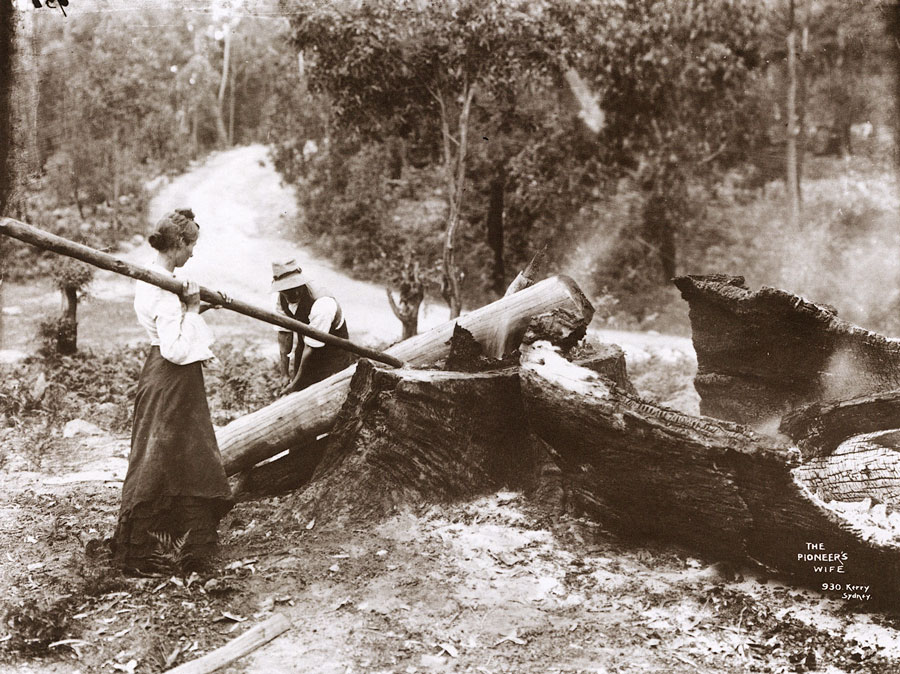 |
Plate 35: The Pioneer's Wife
This George Bell photograph illustrates the hard lot of selectors on new farms. Interest rates were frequently high, if not extortionate, and, as many selectors were undercapitalised, the result meant long hours of work to keep up the cash flow demanded by bank managers and storekeepers. |
| |
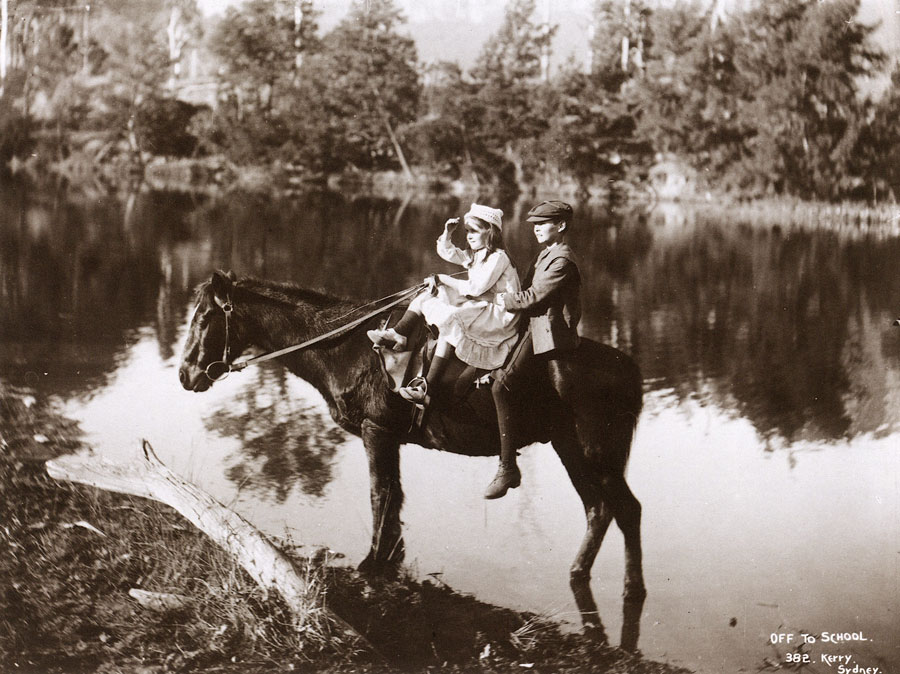 |
| Plate 36: Off To School |
| |
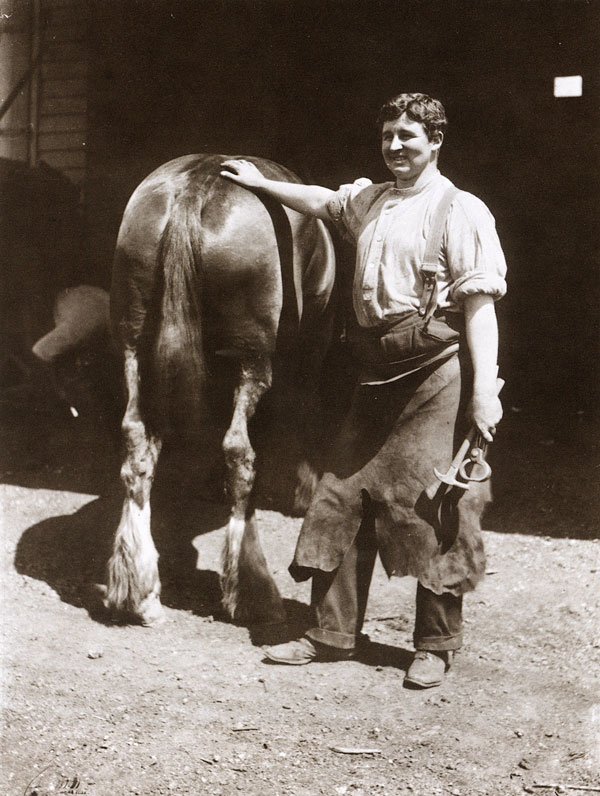 |
Plate 37: Blacksmith
|
| |
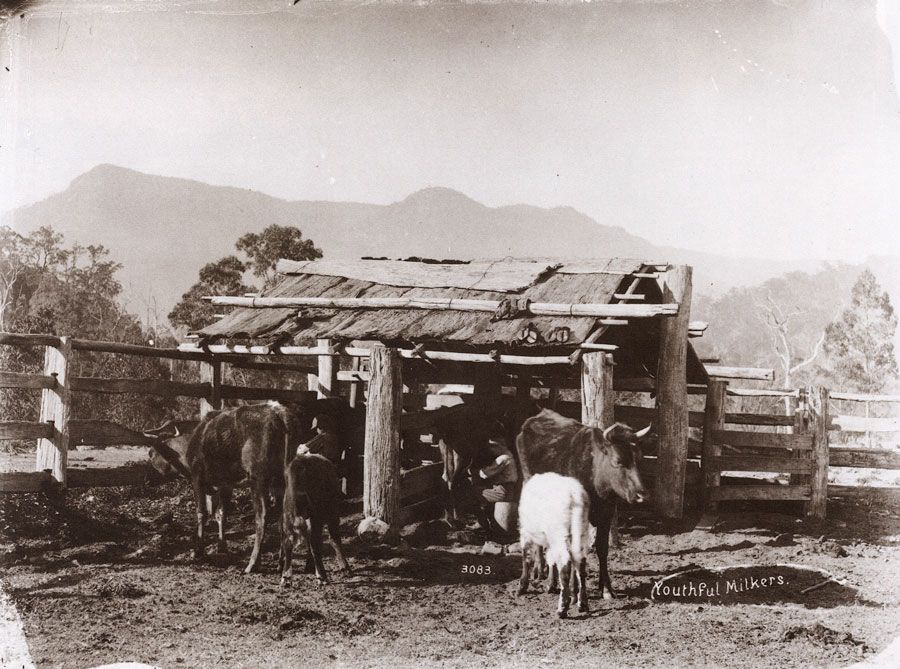 |
Plate 38: Youthful Milkers
For decades, children, as Henry Lawson recalled of his own boyhood, were kicked out of bed before sunrise to milk the cows before riding several kilometres to school. It was a hard life, but on a selector's farm every pair of hands was needed to make ends meet. |
| |
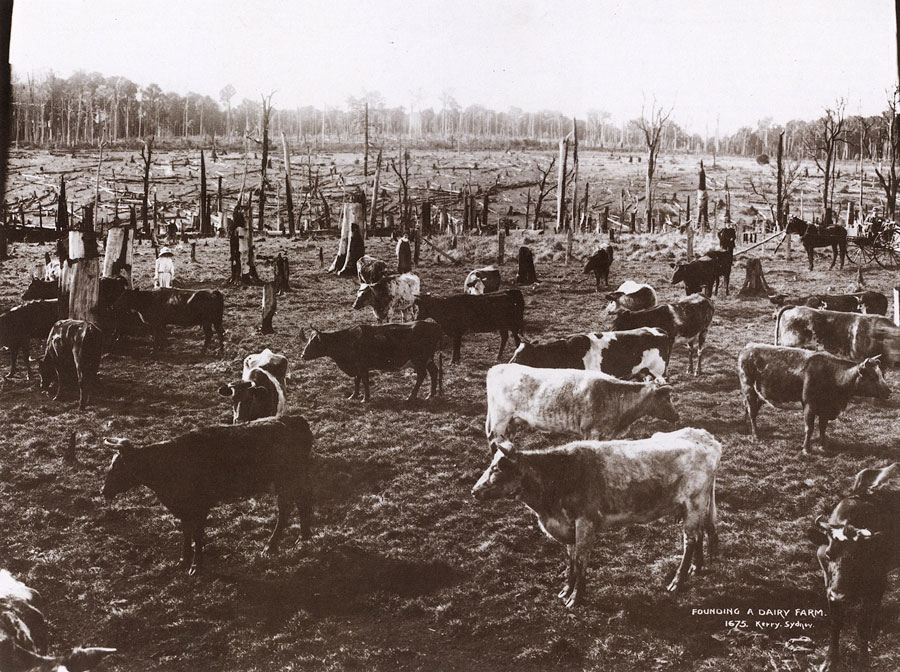 |
Plate 39: Founding A Dairy Farm
Here we see a selector's farm at Dorrigo, inland from Coffs Harbour, with pasture being reclaimed from eucalyptus bush. Grass seed has been scattered amongst the blackened stumps, which would eventually be removed by bullocks. |
continue to Set Two - plates 40–72 (Click here):
Rural Industry Plates 40–46 / Recreation Plates 47–50 / Wheat Farming Plates 51–53 / Sheep Farming Plates 54–65 / Cattle Farming Plates 66–72
>>cover & contents page | Rise & Fall of Kerry & Co | The Man & The Photographer | The Collection | The Plates | Biography | Kerry page
|